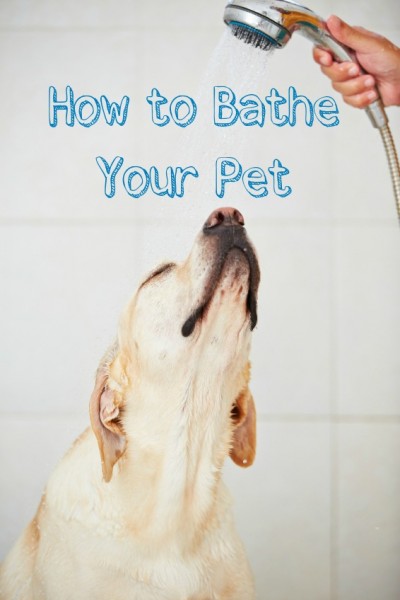Sunday, November 22, 2015
How to Bathe Your Pet Properly


Pets do not usually need frequent bathing – the natural oils in their skin, shedding, a good diet, and their instinctual grooming habits keep them clean and their skin and hair healthy. However, our furry family members sometimes need a bit of extra help. There are times when an excess of hair and unpleasant smells can be a bit overwhelming and a good scrub is the only thing that will make snuggling on the couch tolerable again!
Follow these tips when giving your dogs, cats, bunnies, and other furry friends a good bath.
1. Try to make a bath a calm experience, if not a pleasant one.
Some pets love the water. Some pets don’t.
For those who don’t appreciate the whole soggy business, take extra steps to make bath time a bit more soothing. Make sure all of your bathing supplies and a dry towel are within reach. Water temperatures should be comfortably warm or perhaps cooler on a hot day.
Consider having a few treats ready to give your pet throughout the bath. Talk quietly and use your pet’s name frequently for reassurance.
Consider placing a rubber mat in your tub to keep your pet from slipping. Ask for help from a friend if you think you might have a hard time keeping your pet safely in the tub.
2. Follow a routine like the one you have when you bathe yourself.
Do what you already know how to do. Use warm water to get your pet wet down to the skin so that they are ready for shampooing. If they can tolerate a “sprayer” like a detachable shower head or garden hose, this may be the easiest way to go. Put the sprayer on a gentle setting. Alternatively, you may use a bucket to dip fresh water and gently dump it over your pet’s back. Use an appropriate amount of shampoo based on your pet’s size and length of hair, then softly scrub it into the hair and skin. Avoid sensitive areas around the face (nose, ears, eyes, and mouth) and be gentle when scrubbing other sensitive body parts. If needed, use a damp rag (no soap) to clean your pet’s face. Rinse thoroughly using warm water so that leftover soap doesn’t irritate the skin.
3. Keep your pet in a warm environment until they can dry fully.
Once she has been rinsed, wrap your pet up in a towel and begin drying. Remember that it is natural for many pets to shake when wet, and unless you plan on preventing this, you may want to keep them in a warm, open area that can stand a bit of a shower! Some pets can tolerate a blow dryer. If you do use one, keep it on a warm (not hot) setting and hold the dryer about ten inches away from your pet. This may also be a good time for gentle brushing, especially for long-haired pets. Never let a wet pet out in cold temperatures, as wet skin and hair make it hard to keep warm.
More tips for how, when, and where to wash your pets:
Always allow your pet to remain upright in the bath – don’t force an animal, particularly a rabbit, onto its back, as this is a very vulnerable position and can trigger defensive stress.
Healthy pets can be washed as frequently as once a month. Bathing your pet more often than this tends to dry out their hair and skin. If your pet needs special skin care, consult a veterinarian or professional groomer.
A very smelly pet may require more than one shampooing. You may also try a vinegar rinse: use one cup of vinegar in one gallon of water and pour it over your pet from the neck down. Rub it into your pet’s hair and skin and dry your pet as you normally would without rinsing the vinegar mixture out of his hair.
Pet shampoos of all kinds can be found at your local pet store or found online, such as this organic shampoo on amazon, Avoid using human shampoos, as these tend to dry out pet skin too much and often have added scents and chemicals that are not good for animals.
exception among human shampoos is unscented baby shampoo, which can be used on many dogs and cats. Dawn dish soap (original variety) has often been suggested as a flea-killing shampoo option for pets.
Always be aware of your pet’s individual needs. Some pets have allergies to ingredients in popular pet shampoos (oatmeal can be a challenge for many dogs). If at any time you feel your pet’s safety is compromised, rinse your pet thoroughly, stop the bath, and consult a veterinarian.
Source:TipsAholic
Labels:
Animals
Subscribe to:
Post Comments (Atom)
No comments:
Post a Comment